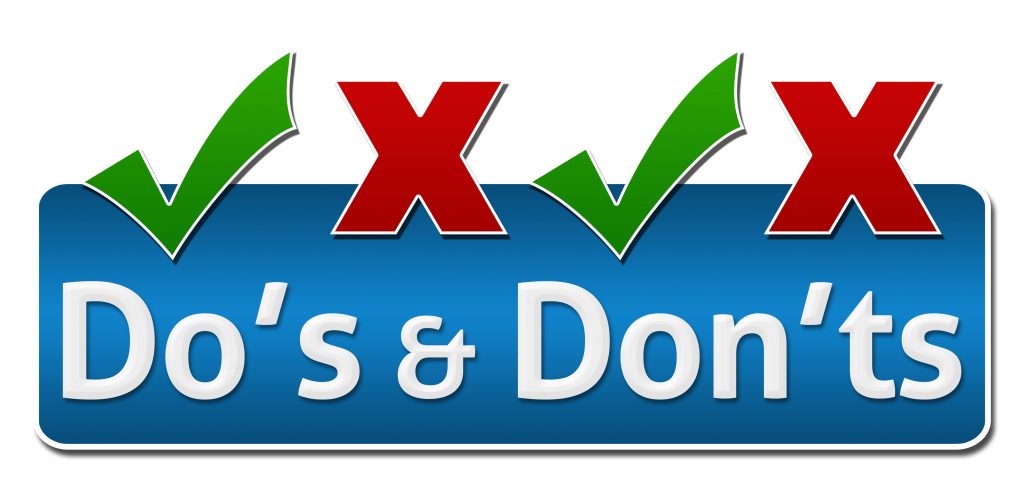
The do’s and don’ts for getting a home mortgage loan have changed a bit since interest rates started climbing. In addition, some of the old assumptions about mortgage loans are simply wrong.
Let us begin with the don’ts…
- Don’t assume that you need a 20% down payment.
This assumption has been around seemingly forever, and for most of those years it simply has not been true. Some loans require far less. Fannie Mae has a 3% down first-time buyer program, and FHA requires only 3.5% down on approved credit. Do keep in mind that borrowers must pay for private mortgage insurance when paying less than 20% down.
In addition, VA has a zero down payment program for veterans and members of the military.
- Don’t focus exclusively on the interest rate.
Naturally every borrower wants the lowest possible interest rate. However, sometimes that lower interest rate is too expensive!
Lenders with big splashy ads touting the lowest rates anywhere are probably not telling you the whole story. That is that to get that rate you may have to pay points.
Points are a fee that lenders can charge to “buy down” the rate. Essentially, what it amounts to is pre-paid interest. Each point equals 1% of the loan amount, so one point on a $300,000 loan would be $30,000.
Mortgage seekers, therefore, must ask potential lenders for an estimate of all costs and fees associated with obtaining a loan at the interest rate they quote.
They must also remember that different lenders have different programs, so it is wise to shop around.
- Don’t choose a loan program without exploring the alternatives.
As stated, there are an abundance of loan programs to choose from. You might be best off with a conventional loan – or with FHA, VA, or USDA.
Different lenders offer different programs and some loan officers may not even be aware of the other programs available.
Do your own research and talk with more than one lender.
- Don’t confuse pre-qualification with pre-approval.
Years ago, home buyers could get a pre-qualification letter from a lender and use it to go shopping. Today, most home sellers demand that potential buyers have a pre-approval in hand before touring their homes.
Why? What’s the difference between them?
A lender can give you a pre-qualification letter based on a conversation. They ask about your income and your obligations and then say “I think you’ll qualify for a loan up to X dollars.”
That doesn’t count for much today.
A pre-approval is completely different. The borrower fills out all the same paperwork necessary to apply for a loan. Then the lender verifies all the information, just as if they were ready to go forward on that loan immediately.
Many savvy buyers today take this a step further and become fully approved. They can then approach a homeowner with a letter verifying that they can pay the amount they’ve offered.
Full approval in advance can also mean that the loan will close much faster than normal.
Do keep in mind, however, that even a fully approved borrower can be rejected at the last minute. Lenders do check again before closing, so borrowers who were foolish enough to quit their jobs, empty their bank accounts, or buy a new car before closing will likely not be buying a house.
- Don’t assume that you can get a loan instantly.
There is no instant gratification when it comes to getting a home mortgage loan.
First you’ll fill out the paperwork. Then the lender will check your credit and verify things like your employment, your bank accounts, and your obligations. They’ll want to know the source of your down payment, and if it has not been in your bank account for at least six months, they’ll want proof of where it came from.
After that’s done, they’ll call for an appraisal, because no bank wants to lend more than a house is worth.
- Do take time to understand all of the fees and costs in addition to your down payment.
In addition to a down payment and a fee to the closer for “closing costs,” borrowers pay for title insurance, an appraisal, a home inspection, and homeowner’s insurance. These additional charges can easily add $5,000 to $12,000 to the funds needed to close.
- Do consider first-time homebuyer programs.
You might as well take advantage of help that is freely offered!
Go on line to look around, then talk with lenders about programs available. Different communities have different offerings, so be thorough in your search. Some offer help with closing costs and/or down payments, some offer lower interest rates or tax credits, and if you’re a first responder or educator, they may be programs just for you.
- Do check your credit score before you do anything else.
This number offers a numerical opinion of you and the way you handle your finances. Because it reflects how well you’ve paid your obligations in the past, it will determine the amount of interest you’ll be required to pay when obtaining a home mortgage loan.
If you’ve had a few bumps in the road that caused your score to go down, the time to address the problem is before you apply for a mortgage loan.
You may be able to bring your scores up significantly simply by paying off a credit card – or even by moving debt from one card to another. This is a topic to explore with a mortgage lender you trust, because he or she can give you helpful advice.
Order a copy of your credit report and read it carefully, because mistakes and identity theft do happen. So check to see that:
- Every account listed is really yours.
- Your address on every account is correct.
- That the spouse named on every account is really your spouse.
An error with any of those things could indicate that someone else is using your credit, and that could mean trouble for you. If you see such an error, contact the credit company immediately.
- Do prepare for the possibility of a low appraisal.
Given today’s high listing prices and the prevalence of bidding wars, some houses do go under contract for more than their current market value.
As already mentioned, the lender won’t lend more than the appraiser says the house is worth. So what will happen if the appraisal comes in low?
This is a subject you should discuss with your real estate professional. Then the answer to that question should be written into your offer. The possibilities are:
- The agreement becomes null and void and the earnest money is returned to the buyer.
- The seller agrees to sell for the appraised value and the sale goes forward.
- The buyer pays the difference in cash. If they are unable or unwilling to do so, they forfeit their earnest money.
As you can see, having it in writing could prevent future trouble.
- Do take the time to interview lenders and choose the best one for you.
Your real estate agent will advise you to use a local lender, and there’s a good reason for that.
You’ll get the best success when you work with someone who will answer your phone calls – even outside of business hours, if necessary. This is important because questions can come up at unexpected times.
That person should be willing to help you explore your options and come to financial decisions that are in your best interest.
You’ll also do best when you work with someone you like – someone you’re comfortable talking with.
And one more…
Do Call Homewood Mortgage, the Mike Clover Group
We’re known for our fast, friendly service and some of the lowest rates available in Texas. We’re always glad to sit down with you or get on the phone to discuss your options – and we do keep abreast of the special programs available to Texas borrowers.
We’re also glad to show you just what your loan will cost under different scenarios- and to show you exactly what fees and costs would be included in each of them.
If you’re unsure about where you stand, we’ll be happy to take a look at your financial situation and let you know the interest rate we could offer today. And, if your scores need improvement, we’ll provide some sound advice on raising them.
Call us today at 800-223-7409








